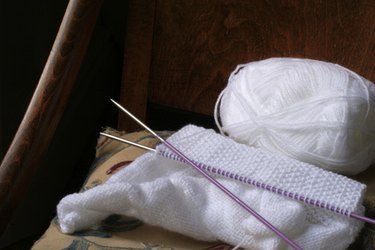Things You'll Need
Graph paper
Pencil
Knitting pattern written for needle knitting

New loom knitters are sometimes frustrated by the lack of available loom knitting patterns in comparison to the abundance of traditional needle knitting patterns. Luckily, traditional needle knitting patterns can be converted with a little bit of knowledge and patience. If the pattern you want to convert is knit in the round then you will just need to reference the chart in the link below to know which stitches to substitute, but if you have chosen a flat piece you will need to rewrite and graph the pattern. This is because when you knit with needles you alternate between working on the "right" and "wrong" side of the fabric, but with loom knitting you are always on the "right" side.
Step 1
Determine if the first row is a "right" side or "wrong" side row. The majority of knitting patterns will say "ws" for wrong side or "rs" for right side to indicate which side of the fabric that row works. If there is no indication either way then assume that the first row is a right side row.
Video of the Day
Step 2
Decide which stitches you will use as substitutions. If you are not familiar with needle knitting you will want to consult a substitution chart such as the one in the link below. You will find that there are many charts available on the Internet and other sources, and chances are, no two are alike. This is because there are several ways to mimic any one needle stitch on a loom.
Step 3
Create a key for your pattern graph. The key is a list of the symbols you will use and the stitches that correlate to them, much like a map key. To make your key, write down a list of each of the stitches you plan to use. Next to that stitch draw a symbol to represent this stitch. The symbol should fit inside of one square on your graph paper. Common symbols include an empty box, a solid dot in the center of the box. an open (not filled on or solid) circle inside the box, and backslashes and forward slashes. If you have worked from graph patterns before you likely already have a set of symbols that you use and are comfortable with.
Step 4
Chart the first row. Assuming that the first row is a right side row, as most are in needle knitting patterns, all you will need to do is plug in the substitutions for the loom knitting stitches. Towards the top of the graph paper place a "1" in a box near the left-hand edge of the paper. Skip a few boxes and then, on the same line, begin filling in the symbols for the stitches. If your pattern begins on a wrong side row refer to step five.
Step 5
Chart row two or your first wrong side row. In the box directly below your "1" on the graph paper write a "2" to indicate that this is row two. The chart symbols for this row will go in the row of boxes directly underneath row one. Before charting the stitches you will need to convert the knitting instructions to work for a right-side row. To do this make any knit stitch a purl and any purl stitch a knit. Then convert to your loom stitches and graph. When graphing this row you will need to start at the right side of the page and work to the right.
Step 6
Continue graphing all rows. Remember that any wrong side row will need to be converted first to a right side row, then to loom stitches and graphed from right to left. Right side rows, on the other hand, are always graphed from left to right.
Video of the Day